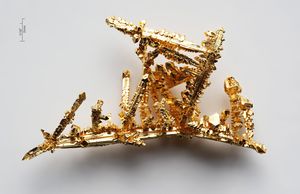Gold is a precious metal and a chemical element with the symbol Au. It is soft and shiny yellow in color. It was used as a monetary unit by many peoples, civilizations and countries. It is also used in the manufacture of jewelry and jewels. The beauty of gold qualifies it to be the preferred material for the manufacture of these delicately designed jewelry.
The value of gold qualifies it to be the primary monetary method for repaying global debt. Photo of the gold store at the Federal Reserve Bank of New York, which keeps the gold reserves of many countries in its vaults.
Gold must be mixed with another metal if we want to make a solid object out of it, such as a piece of jewelry, for example. This mixture is called a slug. Gold bullion is measured in carats, and a carat equals one out of twenty-four parts. Thus, 24 karat gold is pure gold. 18 karat gold is made up of 18 parts gold and 6 parts another metal.
Pure gold melts at 1,064.43°C. It boils at 2,807°C, and it belongs to group 1 of the periodic table of the elements. Its atomic weight is 196,967, and its atomic number is 79. Its density is 19.32 g/cm§ at 20°C. It can be dissolved in a mixture of chlorine acid, nitric acid and called aqua regia.
Gold crystallizes in the cube family, the fully symmetric system (Hexoctahedral). The predominant shape on the crystals is octahedral. The crystals may be in the form of flattened or intertwined trees. The mineral is often found in the form of irregularly shaped sheets, scales, or lumps. Hardness = 2.5 – 3, specific weight = 15.6 – 19.3. Retractable and knockable. There is no cleavage and broken toothed. The color is bright golden yellow or light yellow depending on the amount of silver mixed with the metal.

